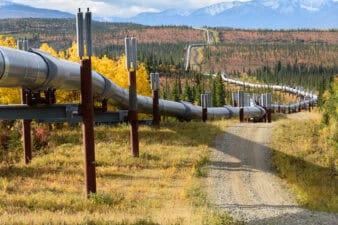Last week’s fourth-quarter and full-year earnings release was a big one for Suncor Energy Inc. (TSX:SU)(NYSE:SU). After one of the worst years for oil prices in recent history, Suncor saw its cash flow plunge by 24%, but it was still able to cover its capital expenditures to post free cash flow of $139 million.
The most important thing about Suncor’s earnings, however, was its 2016 outlook. Suncor announced an 11% reduction in its capital expenditures for the year, and at the same time assumed that West Texas Intermediate oil prices would average US$39/bbl for the year. This is compared to US$49/bbl in 2015, and this $10 drop in prices will also mean that Suncor will not be able to cover its capital expenses and dividends with its cash flow in 2016.
Just how much will this shortfall be? Analysts at both TD Bank and Barclays think that the gap could be as much as $4 billion. To put this in perspective, when you take Suncor’s cash flow in 2015 and subtract the dividend and capital expenditures, the shortfall was only about $1.5 billion. Here’s what this means for shareholders.
Is a $4 billion funding gap possible?
The answer is, it all depends on the price of oil. Analysts at TD Bank believe that this $4 billion shortfall would occur if oil prices were to average $36 per barrel in 2016. This is well above current prices of around $30, but below Suncor’s estimated average of $39.
$36 per barrel is an important number, since this is the price for 2016 that the futures strip is currently forecasting. This is a good indication of where the market thinks prices will be for the year. In 2016 Suncor will need to spend about $6.2 billion on capital expenditures as well as $1.6 billion on its dividend for total spending of $7.8 billion.
According to TD, if prices were to stay at $36 per barrel for the year, cash flows would only be about $3.8 billion, resulting in a $4 billion shortfall (when you subtract what Suncor needs to spend on dividends and capital expenditures). When you factor in the recent acquisition of Canadian Oil Sands, this could be slightly worse.
At $36 per barrel (and assuming the CAD/USD exchange rate is the same as they are now), the Canadian Oil Sands purchase would add about $275 million to Suncor’s cash flow, while also adding $300 million in capital expenditures and $160 million in dividend payments (as a result of the new shares being issued to buy Canadian Oil Sands). This would increase Suncor’s shortfall by $185 million.
Can Suncor afford such a big gap?
Suncor ended 2015 with net debt of $11.1 billion. This is about 1.6 times the company’s cash flow and works out to about 22% of the company’s total capitalization. Overall, these are very reasonable debt levels. This is well below Suncor’s peer group average of 2.2 times cash flow for the year.
Next year, however, these numbers could be much worse. Suncor needs to acquire Canadian Oil Sands debt of $2.4 billion and, in addition to this, Suncor would also be around $4 billion short, which means Suncor’s net debt could grow by $6.4 billion to $17.3 billion.
This would mean Suncor could have net debt that is 4.4 times its cash flow, which would be a fairly high level (but still manageable). While this would not be sustainable for a long period, Suncor would be able to absorb this type of loss for a year or so.
Currently, Suncor has $4 billion in cash sitting in the bank and about $7 billion of unused credit lines that it could draw on if needed. This gives Suncor $11 billion to work with, which is more than enough to cover a $4 billion shortfall in 2016. Any longer, however, and Suncor would need to take more drastic measures, such as reducing its dividend or capital expenses.







